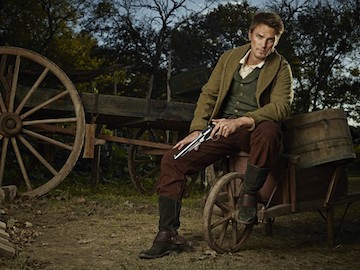Deliverance Creek, written by Melissa Carter. Produced by Nicholas Sparks. Lifetime, September 13, 2014 (Premiere).
The best thing about the Lifetime original movie/”First Original Nicholas Sparks Television Event” may be its poster. A woman stands alone in a desolate landscape with stormy skies. Smoke billows up behind her. She is hunched over and looking pensively at the ground, but her hair—unnaturally vivid red hair—whips up and away from her head like crackling flames. The text reads: CIVIL WARRIOR.
It might seem odd that Lifetime premiered a movie—as a test-run for a series— about the American Civil War. But Deliverance Creek is most definitely a Lifetime movie in that it stars a female protagonist who is in almost constant danger, using a formula that Margaret Lyons has called “melodramatic danger porn.”

Thus, setting this film in 1863 Missouri, in the midst of an increasingly violent guerrilla conflict, makes total sense for Lifetime. The woman, Belle Gatlin Barlowe (Lauren Ambrose), is in danger from every quarter: Union soldiers come after her for harboring guerrillas in her house; slave catchers nearly find out that she is harboring runaway slaves in her root cellar; the bank pursues her relentlessly for the mortgage payment on her ranch; the lecherous next-door-neighbor—well, he just pursues her. All of these things end badly, of course, with the death of a family member and a turn to the dark side for Belle.
The guerrilla warfare components of Deliverance Creek pretty accurately reflect the numbers, the tactics, and the environment (although the movie was filmed in Texas) of guerrilla activities during wartime—and the gaunt, ragtag scruffiness of is perpetrators. The movie also (although probably not intentionally) reflects current scholarship on Civil War guerrillas, which focuses on gender and the home front as battlefield in this region: LeeAnn Whites’ work on the domestic supply line and “girl guerrillas,” Joseph Beilein Jr.’s research on guerrillas as icons of masculinity, and Matthew C. Hulbert’s analyses of the homefront and guerrilla memory.

Matt–who, like me, stayed in on a Saturday night to watch the premiere–thinks that Deliverance Creek also reflects the enduring narrative of guerrilla warfare put forth by the late Michael Fellman in Inside War: The Guerrilla Conflict in Missouri: that “bushwhackers took to the bush for anything but genuine ideological reasons; instead, they went because of criminal deficiencies, to quench a perverse sort of frontier blood lust, or as an outlet for outright psychopathy.” One of the characters represents this dominant narrative: Cyril Balfour (Christopher James Baker), a “Reckless Confederate Renegade” (as described on the show’s website), who has a necklace made of Yankee ears and murders his own comrades.
The movie also throws in other guerrilla stereotypes: men who rode with Bloody Bill Anderson and William Quantrill (recognizable names, those); the natural leader with strong ties to the home front; the injured guerrilla who brings trouble down on the house that shelters him. The Unionist characters, for their part, are either vicious capitalists or radical abolitionists. There is no in-between.
About half-way through, the movie turns from a guerrilla warfare story into a revenge epic/bank robbery caper whose heroine is a literate fugitive slave. When this happens, Deliverance Creek abandons the grittier, nastier vision of the war that characterized this region–and whatever momentum it had as a historical film.
We have seen this turn to the “Western” recently, as a way to narrate the Civil War (and slavery and emancipation)—AMC’s Hell on Wheels, for example, and Quentin Tarantino’s Django Unchained. It is an interesting way to examine racial and sectional conflict in a landscape without traditional battlefields—but it also serves to reinforce the common belief that there was no “real Civil War” in this region. Here, it was all about local conflicts that had no bearing on the developments in national politics or the military situation in the eastern theater. And as Matt rightly notes, converting guerrillas into Western outlaws allows these men—who violated Victorian codes of masculine honor, chivalry, and valor—to become “useful parts of the American experience” while “keeping the Civil War nice and clean and civilized.”

It will be interesting to see if Lifetime picks up Deliverance Creek for a season or two. The ending of the movie is a cliffhanger and if the comments section on its website are any indication, there are a lot of ladies across America who would like to see more of Belle Barlowe and her band of guerrilla bank robbers.
As we await this momentous decision, there is no need to reach for the remote: “The Unauthorized Saved by the Bell Story” is coming up next.
I believe a good argument can be made that the Civil War actually began in Kansas in the mid-1850’s after the passage of the Kansas-Nebraska Act, in which politicians (notably Stephen Douglas) gave these new territories the right to decide (“popular sovereignty”) whether they would be free or slave. These politicians hoped to appease both northern abolitionists and southern slave-holders, but it had the opposite effect by polarizing and hardening their positions to the point of widescale violence against their respective opponents. This “undeclared” guerrilla war – or more appropriately, atrocities – were simply an extension of this violence begun years earlier, albeit with “credibility” given it by some by the declared war of 1861 – 1865.
If this does get picked up as a series, I’ll be curious to see where they pick up chronologically (after leaving off in ’63). Would Lifetime dare try to interpret the Centralia Massacre… maybe with a female guerrilla in the mix? THAT would be the definition of “melodramatic danger porn.”
Any German immigrants in the film?
Not that I can recall. Just one of many ways this film diverges from the much superior “Ride with the Devil.”
Finally! Here I was wondering when Megan was gonna mention Ride with the Devil.